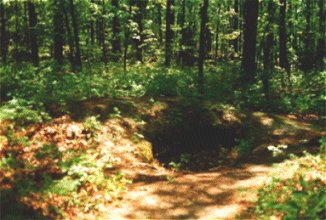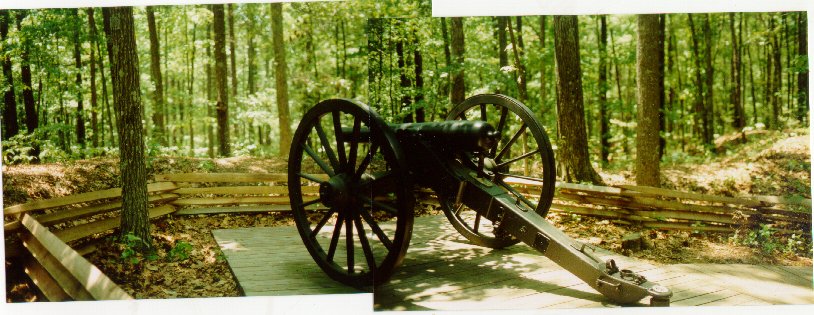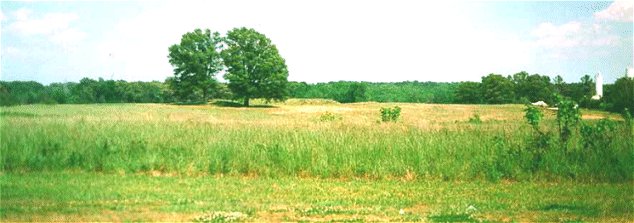
Petersburg Breakthrough
April 2, 1865
When Gen. Grant heard of the great victory at Five Forks, he ordered a general assault on Petersburg for April 2nd, the next day. Parke's IX Corps attacked Fort Mahone with little success, but further west, Wright's VI Corps made a decisive breakthrough.
At 10 P.M. on April 1st, a massive bombardment began of the whole Confederate line. At 2 A.M. on April 2nd, the bombardment stopped and the 14,000 men of the three divisions of Wright's corps moved out of their fortifications and deployed for the attack in three columns.

Confederate Picket Line
Shown here is one of the well preserved rifle pits at Pamplin Park Civil War Site. This pit was positioned with several others on a protuberance and covered all avenues of approach. The picket line was on a small hill and overlooked the Federal assembly area. Because of its commanding position, it had been captured a couple of weeks before, allowing the Federals to mass in secrecy.

Confederate Line
These remarkably well preserved Confederate earthworks were first begun in October of 1864, and were manned by McGowan's Brigade of South Carolinians. Because of the continual Federal attempts to flank Petersburg, Lee's forces were stretched thin.
At 4:40 on April 2nd, the signal gun was fired and the Federals began to charge. The ground in front of the works was rolling and uneven. This combined with the small numbers of defenders meant that the Federals were able to reach and breach these defenses.

Artillery Position
The center Union column assaulted and carried this artillery redan in fierce hand to hand combat. The VI Corps had breached the works on their front. It had cost them 1,100 men in 20 minutes of combat. A.P. Hill was in command of the troops on this sector, so when he heard firing, he rushed to the front. As he approached the area, he came upon two Union soldiers. He commanded them to surrender, but the Yankees responded with gunshots that killed him.
After the breakthrough, Wright moved not towards Petersburg, but southwest to completely clear out the Confederate defenses all the way to Hatchers Run. This freed up Gibbon's XXIV Corps and helped Humphrey's II Corps to breakthrough and join them. These three corps combined and moved on Petersburg's western defenses.

Fort Gregg
Pictured here is Fort Gregg as seen from the perspective of Gibbon's XXIV Corps which came upon it at one o'clock on its way to Petersburg. The Boydton Plank Road leading into Petersburg is near the white towers on the right of the picture. Fort Gregg and Fort Whitworth, which is off the picture to the left and on private property, were built in front of Petersburg's western defenses specifically for the purpose they would now serve. Petersburg's western defenses in the picture were in the trees on the horizon. Since Wright's VI Corps had moved southwest after its breakthrough to clear the whole line, Longstreet's men had time to begin moving into the western defenses. Brigadier Gen. Lane's men were first to reach the forts, but when Harris's brigade approached, some of them were also sent into the forts. In all, 214 men defended Fort Gregg, and they would be outnumbered ten to one by their attackers.
After a half hour bombardment, the assault began. The defenders of Fort Gregg had collected a number of rifles for each defender, so when Foster's Union division began the attack, they were for a while met by firepower comparable to that of repeating rifles. Still, the Federals continued the attack and reached the muddy ditch. Some troops made their way to the rear of the fort, but they were met by fire from loopholes from a log palisade. The Confederates withdrew from Fort Whitworth, and the Federals from this sector moved across the field on the left of the picture onto Fort Gregg. These reinforcements would be vital in taking Fort Gregg.
By this time, the Rebels were almost out of ammunition, and the Federals began to scale the walls and engaged in hand to hand combat. The defenders knew how vital their mission was and were not eager to surrender, while the enraged Federals were not in the mood to give quarter. Only 30 of the 214 defenders survived unscathed. The Confederate defenders sustained 55 killed and 129 wounded. Union forces suffered 122 killed and 592 wounded. Through this bloody battle, Lee's army was saved from destruction. That night, he evacuated Petersburg and Richmond. On April 9, 1865, Lee surrendered at Appomattox Courthouse.
Back to Civil War Virtual Battlefield Tours